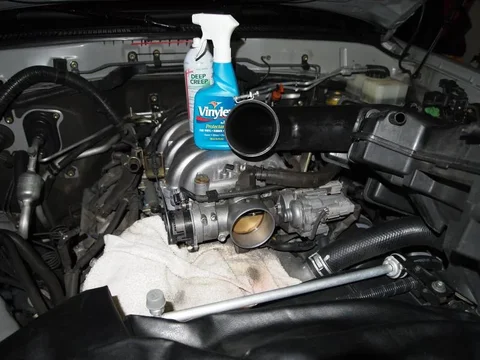Throttle Plate Spray Cleaning, Idle Air Bypass
Hi All,
This LC99 UZJ100 with over 250k miles idles smoothly, and gas mileage is not bad either (14mpg average) but a few weeks ago, especially after a fast drive of about 50 miles, I noticed that the idle speed in D dropped to below 600rpm, which wasn't moving the vehicle when I released the brakes.
I inspected the throttle plate, and wiped it clean by hand, using SeaFoam DeepCreep (a multipurpose cleaner, lubricant type). In that process, I removed a decent amount of carbon deposits from the finger-reach area behind the throttle plate. This cleaning immediately increased the cold-idling speed (before engaging any gears) to about 1200rpm, and warm idling is about 800rpm. So, I figure more cleaning could help. I am not able to disassemble the throttle body, so I'm hoping to do a SeaFoam Spray treatment.
Please note that the SeaFoam spray is introduced thru’ the air intake, as opposed to the traditional SeaFoam engine treatment, which is introduced through vacuum lines, of which a lot of posts are found. I hope to do this cleaning over the weekend, and will report back. I have several questions in this regard:
1. SeaFoam instructions specify that while applying the spray the engine speed should be well above the factory idle speed so that the spray would enter thru the throttle plate opening, and not thru' the idle air bypass. But as my photos show, and as far I can see with eyes, I don't find an idle air bypass opening before the throttle plate in this engine (2UZ-FE). How come? Does this means that I don't need to rev up much while introducing the spray?
2. Should I desire to increase the idling speed while spraying, and if I have to do the project on my own, is it ok to pull on the throttle cable in the engine compartment?
3. I figure that after cleaning, the idle speed will increase again. To get the car to re-learn the idle speed, do I need to disconnect the battery cables for a while, before driving it around?
Thanks in advance.



Hi All,
This LC99 UZJ100 with over 250k miles idles smoothly, and gas mileage is not bad either (14mpg average) but a few weeks ago, especially after a fast drive of about 50 miles, I noticed that the idle speed in D dropped to below 600rpm, which wasn't moving the vehicle when I released the brakes.
I inspected the throttle plate, and wiped it clean by hand, using SeaFoam DeepCreep (a multipurpose cleaner, lubricant type). In that process, I removed a decent amount of carbon deposits from the finger-reach area behind the throttle plate. This cleaning immediately increased the cold-idling speed (before engaging any gears) to about 1200rpm, and warm idling is about 800rpm. So, I figure more cleaning could help. I am not able to disassemble the throttle body, so I'm hoping to do a SeaFoam Spray treatment.
Please note that the SeaFoam spray is introduced thru’ the air intake, as opposed to the traditional SeaFoam engine treatment, which is introduced through vacuum lines, of which a lot of posts are found. I hope to do this cleaning over the weekend, and will report back. I have several questions in this regard:
1. SeaFoam instructions specify that while applying the spray the engine speed should be well above the factory idle speed so that the spray would enter thru the throttle plate opening, and not thru' the idle air bypass. But as my photos show, and as far I can see with eyes, I don't find an idle air bypass opening before the throttle plate in this engine (2UZ-FE). How come? Does this means that I don't need to rev up much while introducing the spray?
2. Should I desire to increase the idling speed while spraying, and if I have to do the project on my own, is it ok to pull on the throttle cable in the engine compartment?
3. I figure that after cleaning, the idle speed will increase again. To get the car to re-learn the idle speed, do I need to disconnect the battery cables for a while, before driving it around?
Thanks in advance.
Last edited:






 << Road trip, to disperse the 44K & blow-out Sea Foam products throughout fuel, air & oiling systems. I didn't replace engine cover yet, so I can spray a little before each engine shut downs, repeat soak (spraying) until can empty.
<< Road trip, to disperse the 44K & blow-out Sea Foam products throughout fuel, air & oiling systems. I didn't replace engine cover yet, so I can spray a little before each engine shut downs, repeat soak (spraying) until can empty.